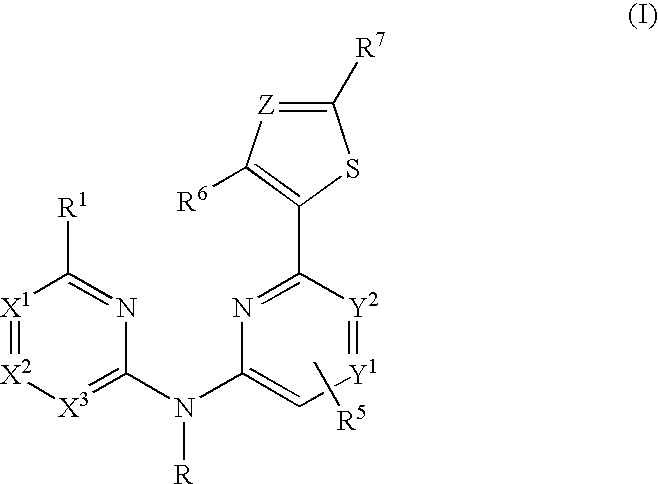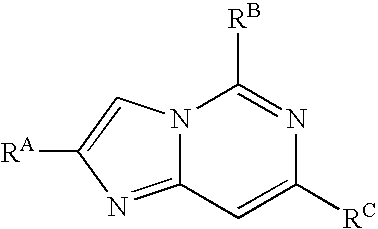Aminopyridine compounds having Syk inhibitory activity
a technology of syk inhibitors and compounds, applied in the field of new drugs, can solve the problems of gastrointestinal allergy, swelling and itching, asthma attack,
- Summary
- Abstract
- Description
- Claims
- Application Information
AI Technical Summary
Problems solved by technology
Method used
Image
Examples
production example 1
Process Chart 1
[1229]
(wherein X represents a leaving group such as a halogen atom, and R7′ represents a nucleophile substituent among R7, and each other symbol represents the same meaning as above.)
Step 1
[1230]Compound (3) is obtained by subjecting compound (2) to halogenation using a halogenating agent such as thionyl chloride, oxalyl chloride in a solvent such as dichloromethane, 1,2-dichloroethane, chloroform, carbon tetrachloride, acetonitrile, toluene or to a reaction using a leaving group inducing reagent such as methanesulfonyl chloride, p-toluenesulfonyl chloride, trifluoromethane sulfonic acid anhydride in the presence of a base such as triethylamine, N,N-diisopropylethylamine and pyridine.
Step 2
[1231]Compound (5) is obtained by converting compound (4) to a thiourea using 9-fluorenylmethoxycarbonylisothiocyanate, piperidine in a solvent such as ethanol, isopropanol, ethyl acetate, tetrahydrofuran, N,N-dimethylformamide, dimethylsulfoxide, chloroform, acetonitrile, ethylene ...
production example 2
Process Chart 2
(Each symbol in the chart represents the same meaning as above respectively.)
[1234]
Step 5
[1235]Compound (10) is obtained by reacting a nicotinic acid chloride compound (8) and malonic acid compound (9) in a solvent such as acetonitrile, tetrahydrofuran, 1,4-dioxane, N,N-dimethylformamide in the presence of magnesium chloride and a base such as triethylamine and N,N-diisopropylethylamine following a method described in Organic Letters, 5 (18), 3233-3236, (2003) and further performing decarboxylation and deprotection of the tert-butoxycarbonyl group using a concentrated hydrochloric acid at the same time.
Step 6
[1236]Compound (12) is obtained by reacting compound (10) with compound (11) in a solvent such as acetonitrile, tetrahydrofuran, 1,4-dioxane, N,N-dimethylformamide, dichloromethane, 1,2-dichloroethane, chloroform, carbon tetrachloride. In this reaction, bases such as pyridine, triethylamine, N,N-diisopropylethylamine may be used depending on the case. When compoun...
production example 3
Process Chart 3
[1238]
Step 8
[1239]Compound (15) can be obtained by reacting compound (7) and compound (14) according to the method shown in Step 4.
Step 9
[1240]Compound [I] can be obtained by reacting compound (15) with compound (16) in a solvent such as dimethoxyethane, diethyl ether, acetone, butanone, dioxane, tetrahydrofuran in the presence of tetrakis(triphenylphosphine)palladium and a base such as sodium hydrogen carbonate, potassium bicarbonate, sodium carbonate, potassium carbonate.
[1241]When compound [I] having a “—CONH-bond” in substituent R7 is desired, the desired compound [I] having a “—CONH-bond” can be obtained by subjecting a compound having a “—COOH group” and a compound having a “—NH2 group” to amidation reaction.
[1242]In addition, when compound [I] having “—N(-(substituted)C1-6 alkyl)-” in substituent R7 is desired, a known alkylation reaction may be performed using a compound having “—NH—”.
[1243]When compound [I] having a “—CH(OH)—” in substituent R7 is desired, a ...
PUM
| Property | Measurement | Unit |
|---|---|---|
| Rg | aaaaa | aaaaa |
| body weight | aaaaa | aaaaa |
| temperature | aaaaa | aaaaa |
Abstract
Description
Claims
Application Information
 Login to View More
Login to View More - R&D
- Intellectual Property
- Life Sciences
- Materials
- Tech Scout
- Unparalleled Data Quality
- Higher Quality Content
- 60% Fewer Hallucinations
Browse by: Latest US Patents, China's latest patents, Technical Efficacy Thesaurus, Application Domain, Technology Topic, Popular Technical Reports.
© 2025 PatSnap. All rights reserved.Legal|Privacy policy|Modern Slavery Act Transparency Statement|Sitemap|About US| Contact US: help@patsnap.com



